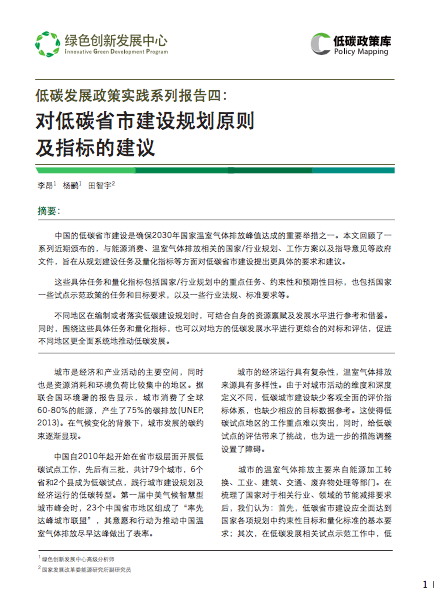Climate Governance
Climate change has gone mainstream in China’s economic policymaking. China is also now an active player in global climate governance, working with the international community and through key bilateral relationships to achieve the Paris goals. China submitted an updated Nationally-Determined Contribution at COP 26 in Glasgow. The challenge now is to ensure that there are no implementation gaps between China’s national-level climate pledge and actions on the ground.
To help push forward progress on national targets, iGDP tracks China’s performance on its periodically updated NDCs, builds models of the country’s national long term strategy, and provides information on China’s climate actions through the Carbon Neutrality Tracker data platform. At the subnational level, iGDP conducts research on zero-emissions planning to assist China’s regional governments in setting local long-term climate goals and designing action plans. iGDP also pushes forward into new areas for climate action such as non-CO2 greenhouse gases, climate-safe cooling, and food system emissions. To promote bilateral dialogue among key climate stakeholders, iGDP organizes workshops and conferences, including a recent US-China climate dialogue at Tsinghua University, and COP side events.

Publications and Events
What to Expect in China's Second Nationally Determined Contribution
2021-07-01
Report
This report is an updated version of our 2019 report on China’s NDC. It reviews the new international and domestic sustainable development trends since the last report and discusses the implementation of China’s first NDC. The second part of the report draws on newly issued strategic plans and policies during the 13th and 14th Five-Year plan periods to explore the climate policy options that may shape China’s second NDC.
China's Carbon Neutral Opportunity
2021-01-01
Report
This joint paper by Energy Innovation, innovative Green Development Program, and the Institute for Finance and Sustainability shows that China has the opportunity to, and should, strengthen its climate commitments by setting a target for peaking its carbon emissions before 2030.
The report shows how clean energy beats fossil fuel technologies on price and makes carbon neutrality an economic driver. By increasing the pace of its domestic clean energy transition, China can induce additional technological innovation to enhance the competitiveness of its clean technology firms, while at the same time improving its energy security and achieving earlier carbon peaking.
LOGIC: Low-carbon & Green Index for Cities
2018-09-13
Report
Low Carbon Cities
LOGIC provides a system to track progress, a database to evaluate performance, and an analytical tool to help cities identify improved solutions for low carbon and clean energy development, and early carbon peaking.

China’s Low Carbon Cities: Carbon Peak Pledges and Progress on Green Transition
2018-06-27
Factsheet
Low Carbon Cities
This factsheet provides an overview of the policies and other actions that China’s low carbon pilot cities have taken to date.

Wuhan Low Carbon Development Strategy and Policy Practices Background Report
2018-06-22
Report

An Integrated Strategy to Assist China's Cities in Achieving an Early Carbon Emissions Peak
2018-01-08
Working Paper
This paper offers a set of enhanced policies and practices to help China’s cities transition toward a deep de-carbonization development path, sustaining economic growth with lower emissions, better air quality, and more livable communities.

Recommedations on Principles and Objective-Setting for Low-Carbon Pilots
2017-09-06
Working Paper

Alliance of Peaking Pioneer Cities Action Fact Sheet
2016-07-15
Working Paper
This factsheet provides key information about China’s Alliance of Peaking Pioneer Cities – a collection of cities that is striving to achieve peak carbon emissions earlier than the national target year.

Low Carbon Cities in China National Policies and City Action Factsheet
2015-09-01
Factsheet
This factsheet provides an analytical review of the actions taken in 10 of the 42 pilots in China’s first batch of low low carbon pilots.




